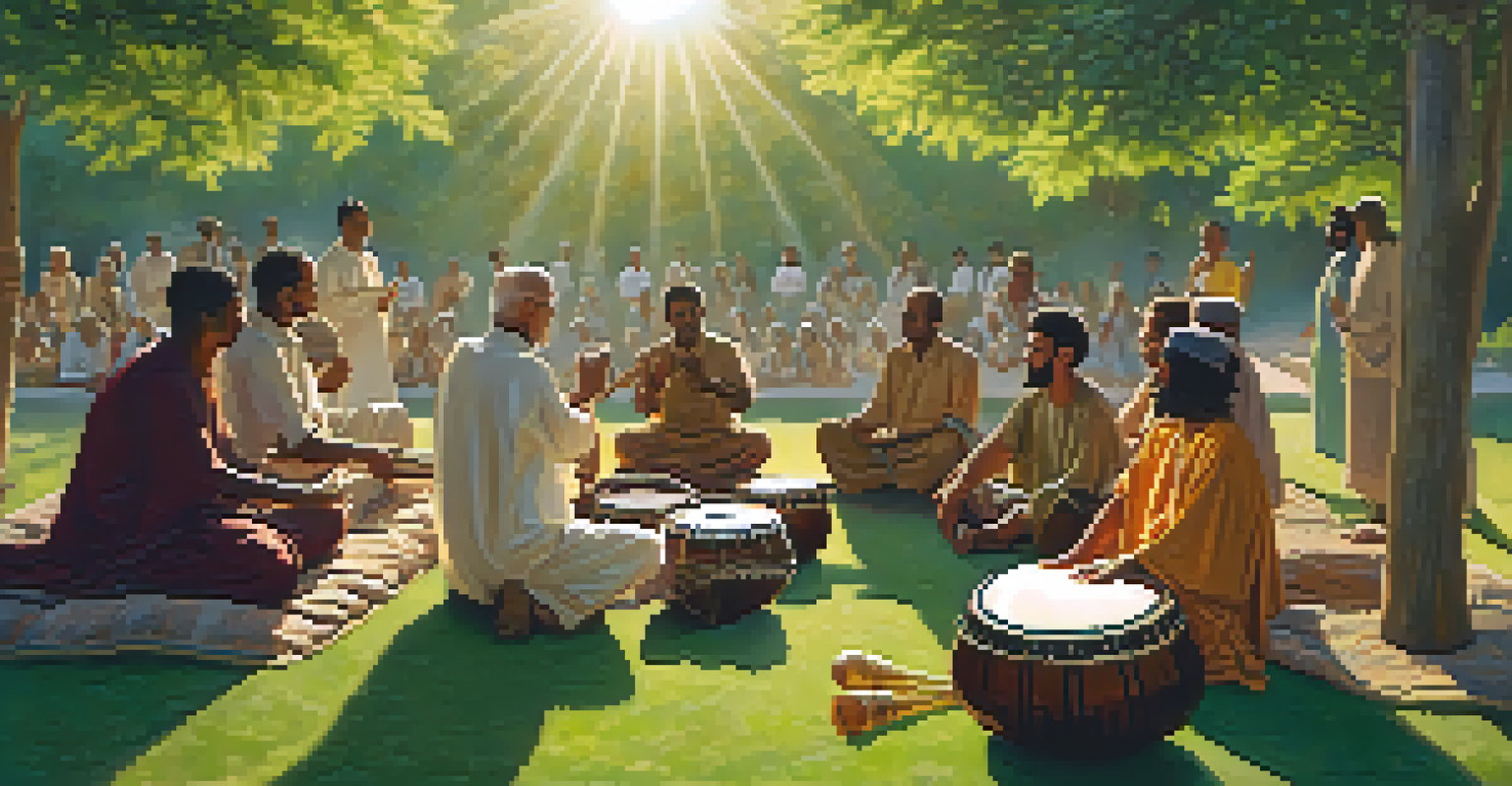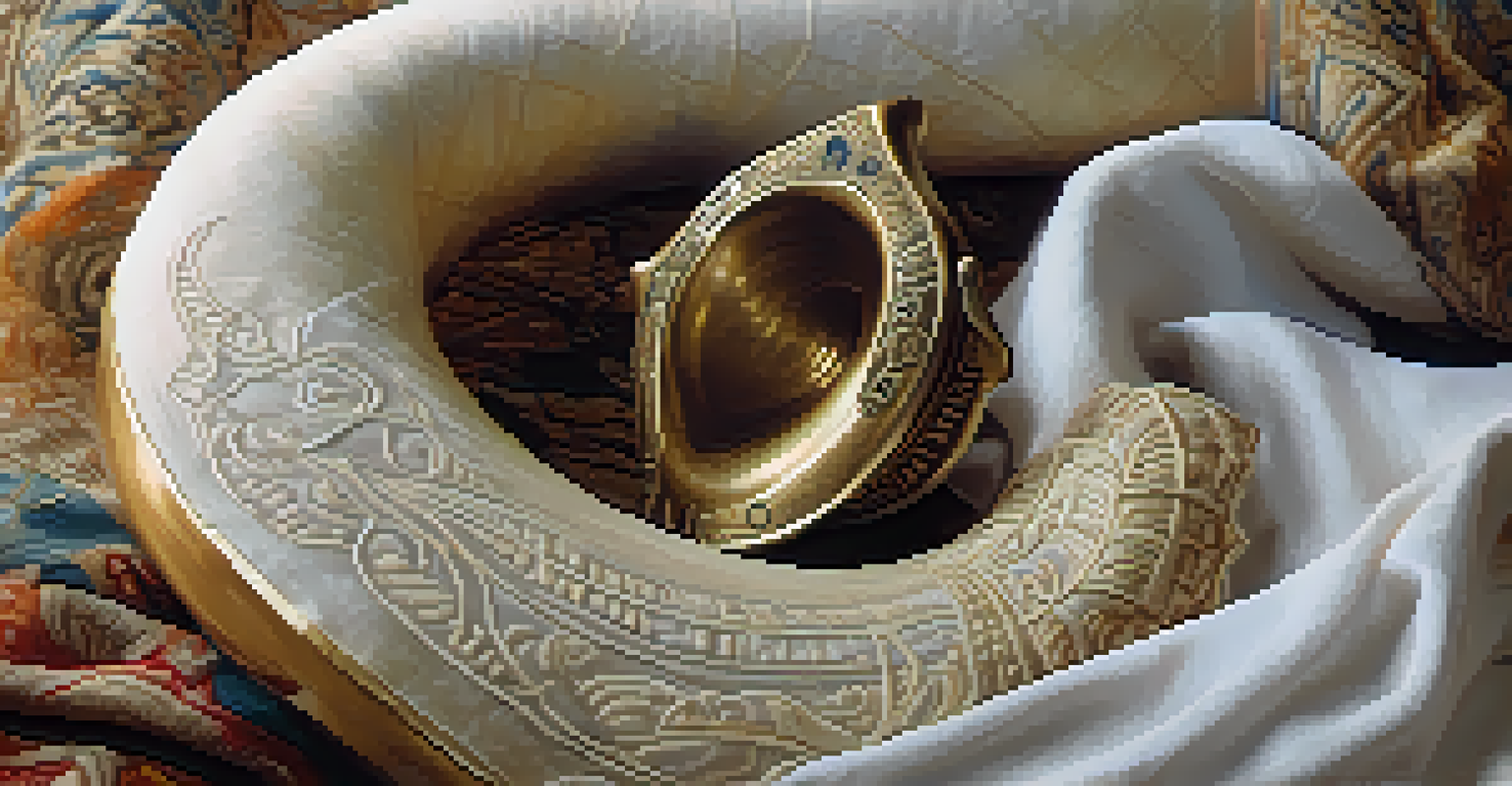Sacred Sounds: The Use of Instruments in Religious Rituals

The Role of Sound in Spirituality and Worship
Sound has always played a pivotal role in spirituality, acting as a bridge between the material and the divine. Many religions incorporate sound into their rituals, believing it can elevate the spirit and connect practitioners to higher powers. From chanting to instrumental music, these sounds create an atmosphere conducive to worship and reflection.
Music can change the world because it can change people.
Instruments often serve as the heartbeat of rituals, guiding participants through various phases of worship. For instance, in Hindu ceremonies, the use of the tabla or harmonium adds layers of depth and emotion to prayers. Similarly, in Christianity, hymns accompanied by organ music can evoke feelings of reverence and community.
Ultimately, sound is not just background noise; it plays a crucial role in shaping the spiritual experience. By engaging with sound, worshippers can feel more connected to their faith, creating a shared experience that transcends individual beliefs.
Ancient Instruments and Their Symbolic Significance
Throughout history, various cultures have developed instruments specifically for religious practices. For example, the shofar, a ram's horn used in Jewish ceremonies, symbolizes awakening and repentance. Each blow of the shofar serves as a call to introspection, reminding participants of their spiritual obligations.

In ancient Egypt, the sistrum—a rattling instrument—was used during rituals to invoke the goddess Hathor. Its unique sounds were believed to attract divine favor and blessings, showcasing how instruments can carry deep spiritual meanings. Such examples highlight the profound connection between sound and sacred symbolism.
Sound Enhances Spiritual Connection
Sound in rituals, from chanting to instrumental music, creates an immersive atmosphere that elevates the spiritual experience and fosters a sense of community among practitioners.
These instruments are not merely tools; they embody the beliefs and traditions of the cultures that use them. Understanding their significance can enrich our appreciation of the rituals they accompany, allowing us to see them as living expressions of faith.
Cultural Variations in Instrumentation Across Religions
Different religions utilize a diverse array of instruments that reflect their unique cultural backgrounds. For instance, in Islamic traditions, the use of the oud—a pear-shaped stringed instrument—plays a significant role in spiritual gatherings. Its soothing melodies can enhance the atmosphere of prayer and contemplation.
Sound is the vocabulary of nature.
Conversely, African tribal rituals often incorporate percussion instruments like drums, which are essential for creating rhythm and energy. These drums not only serve musical purposes but also facilitate communication with ancestors and spirits. This illustrates how the choice of instruments can vary widely, shaped by cultural contexts and spiritual needs.
Such diversity in instrumentation enriches the religious landscape, offering a variety of sounds and styles that resonate with different audiences. By exploring these variations, we can gain insights into how culture and spirituality intertwine.
Instruments as Tools for Meditation and Reflection
In many religious practices, instruments are employed as tools for meditation and self-reflection. For example, Tibetan singing bowls produce harmonious tones that promote relaxation and mindfulness. Practitioners often use these bowls to create an atmosphere conducive to deep meditation, allowing them to connect with their inner selves.
Similarly, the gentle strumming of a guitar during a spiritual gathering can invite participants to enter a reflective state. This use of music as a meditative aid demonstrates the powerful impact sound can have on our mental and emotional states. It encourages participants to engage more fully with their spirituality.
Instruments Carry Deep Symbolism
Various religious instruments, like the shofar and sistrum, embody significant cultural meanings and are integral to rituals, enriching the understanding of faith traditions.
In this sense, instruments become extensions of the spiritual experience, helping individuals find peace and clarity. By incorporating sound into meditation, practitioners can enhance their spiritual journeys and foster a deeper connection with their beliefs.
The Impact of Modern Technology on Sacred Music
In recent years, modern technology has transformed how sacred music is created and experienced. Digital platforms now allow for the recording and sharing of religious music across the globe, making it accessible to a wider audience. This has opened up new avenues for people to connect with sacred sounds, regardless of their location.
However, this shift comes with both benefits and challenges. While technology can enhance the experience, it may also dilute the authenticity of traditional sounds. Some argue that the essence of sacred music lies in its live performance, where the energy of the moment can be felt by all present.
Navigating this balance is essential as we embrace modern advancements while honoring the traditions of sacred music. By finding ways to incorporate technology thoughtfully, we can enrich our spiritual experiences without losing sight of their origins.
Healing Power of Music in Religious Practices
Many religious traditions recognize the profound healing power of music. In Christianity, for example, hymns are often sung during services to uplift spirits and foster a sense of community. This collective singing can create an emotional release, allowing worshippers to feel connected to one another and their faith.
In Indigenous cultures, drumming and singing are integral to healing ceremonies, believed to restore balance and harmony within the individual. The rhythmic beats and melodic chants create a safe space for emotional expression, facilitating healing on both physical and spiritual levels. These practices demonstrate the therapeutic benefits of music in a religious context.
Technology Transforms Sacred Music
Modern technology has revolutionized how sacred music is experienced and shared, presenting both opportunities for broader access and challenges in preserving traditional authenticity.
By integrating music into healing rituals, these faiths acknowledge the interplay between sound and well-being. This recognition highlights the importance of nurturing the spirit, making music an essential element of the healing process.
The Future of Instruments in Religious Rituals
As we look to the future, the role of instruments in religious rituals is likely to evolve. Cultural exchanges and globalization are introducing new sounds and instruments into traditional practices, creating exciting possibilities for innovation. This blending of musical traditions can enrich spiritual experiences and foster a sense of unity among diverse communities.
However, it's essential to approach these changes with respect for the origins and meanings of the instruments involved. As new sounds are incorporated, we must remain mindful of preserving the authenticity and significance of traditional practices. This balance will be crucial in maintaining the integrity of sacred music.

Ultimately, the future of instruments in religious rituals holds promise for increased creativity and connection. By embracing change while honoring tradition, we can continue to explore the profound relationship between sound and spirituality.